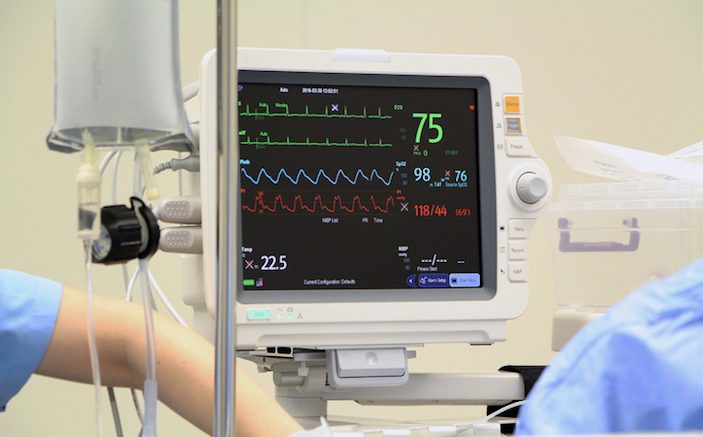Given the difficulty in converting RVF to a perfusing rhythm, here are a few strategies beyond the standard therapy to add to your toolbox.
Refractory ventricular fibrillation (RVF) is a life-threatening cardiac arrhythmia unresponsive to traditional methods of defibrillation and advanced cardiovascular life support (ACLS). RFV has been defined as “ventricular fibrillation that is resistant to at least three defibrillation attempts, 300 mg of amiodarone, and does not exhibit return of spontaneous circulation (ROSC) after > 10 min of cardiopulmonary resuscitation (CPR)” [10]. Without an established effective treatment, the current approach for RVF is standard ACLS care with three possible strategies focused on converting RVF to a perfusing rhythm: beta blockade with esmolol, dual sequential defibrillation (DSD), and withholding or decreasing epinephrine administration.
Dual Sequential Defibrillation
Dual sequential defibrillation (DSD) has been used as an additional method of cardioversion when a patient has been non-responsive to biphasic defibrillation. Multiple case reports have demonstrated the usefulness and feasibility of the technique [2-4,9]. The mechanism behind DSD’s apparent efficacy involves expansion of the defibrillation vector and an ability to overcome the electrical threshold for defibrillation. For example, if an anterior-lateral pad placement is already on the patient, an anterior-posterior placement can be applied from a second defibrillator. This extra set of pads provides an additional area of defibrillation and allows for depolarization of a larger mass of myocardium when compared to two pad defibrillation [3,4]. Two adjacent sets of defibrillator pads can also be used to expand the already existing defibrillation vector. An increased electrical vector may compensate for any user errors or patient abnormalities that would normally lower the efficacy of a defibrillating shock, such as poor pad placement or inadequate pad contact, or morbid obesity [4]. DSD may also overcome any additional elevation in the threshold for successful defibrillation resulting from ongoing cardiac arrest. The relatively simple approach of using a second set of defibrillators makes DSD an easy first choice for treatment of RVF and a feasible pre-hospital therapy [4]. Despite some documented success utilizing DSD, it is not FDA approved, and neither defibrillator equipment standard operating protocol nor manufacturer instruction endorse its use.

Beta-Blockade
Esmolol also offers promise as an adjunctive therapy for stopping RVF [5,10,11]. During RVF and cardiac arrest, increased sympathetic tone through administration of multiple rounds of epinephrine results in increased myocardial oxygen demand, exacerbation of myocardial ischemia, and depression of the VF threshold [5]. In practice, administration consists of 500mcg/kg loading bolus followed by 50-100mcg/kg/min while continuing standard ACLS care. The cases described at Hennepin County Medical Center received the esmolol bolus after a median of 24 minutes of arrest. Of the six cases that received esmolol, four achieved sustained ROSC with three surviving to hospital discharge. Despite this encouraging report, more robust evidence is required before beta blockade can be recommended as a widespread therapeutic option for the treatment for RVF [5,10].
Withholding Epinephrine
Often paired with esmolol administration, intermittent decreases or skipped doses of epinephrine during subsequent rounds of ACLS may lessen the sympathetic surge promoting RVF. Epinephrine has traditionally been recommended for use during resuscitation of cardiac arrest due to the increase in aortic diastolic pressure and coronary artery perfusion [1]. Even when dosing at 0.01mg/kg, epinephrine increases myocardial oxygen demand due to positive ionotropic and chronotropic effects and may contribute to the myocardial dysfunction and electrical instability that leads to RVF [1,5,10]. Although unproven, it is possible that after administering 3-4 rounds of epinephrine, the threshold for myocardial stress is overcome in patients with RVF and withholding dosages of epinephrine while either performing a DSD or administering esmolol may increase successful defibrillation [5].
Conclusion
None of these techniques are proven to offer benefit when compared to standard therapy, but given the difficulty in converting RVF to a perfusing rhythm, all should be considered as options. With DSD being the easiest to perform, it is often cited as a first attempted adjunct, while cessation of epinephrine is best paired with esmolol administration.
REFERENCES
- Attaran RR, Ewy GA. Epinephrine in Resuscitation: Curse or Cure? Future Cardiology. 2010; 6: 473-482.
- Cabañas JG, Myers JB, Williams JG, De Maio VJ, Bachman MW. Double sequential external defibrillation in out-of-hospital refractory ventricular fibrillation: a report of ten cases. Prehosptial Emergency Care. 2015;19:126-130.
- Chang M, Inoue H, Kallok MJ, Zipes DP. Double and triple sequential shocks reduce ventricular defibrillation threshold in dogs with and without myocardial infarction. Journal of the American College of Cardiology. 1986;8:1393-1405.
- Cortez E, Krebs W, Davis J, Keseg DP, Panchal AR. Use of double sequential external defibrillation for refractory ventricular fibrillation during out-of-hospital cardiac arrest. Resuscitation. 2016;108:82-86.
- Driver BE, Debaty G, Plummer DW, Smith SW. Use of esmolol after failure of standard cardiopulmonary resuscitation to treat patients with refractory ventricular fibrillation. Resuscitation. 2014;85:1337.
- Gao D, Sapp JL. Electrical storm: definitions, clinical importance, and treatment. Current Opinion in Cardiology. 2013;28:72-79
- Hoch DH, Batsford WP, Greenberg SM, et al. Double sequential external shocks for refractory ventricular fibrillation. Journal of the American College of Cardiology. 1994;23:1141-1145.
- Leacock BW. Double simultaneous defibrillators for refractory ventricular fibrillation. The Journal of emergency medicine. 2014;46:472.
- Lee YH, Lee KJ, Min YH, et al. Refractory ventricular fibrillation treated with esmolol. Resuscitation. 2016;107:150.
- Nademanee K, Taylor R, Bailey WE, Rieders DE, Kosar EM. Treating electrical storm : sympathetic blockade versus advanced cardiac life support-guided therapy. Circulation. 2000;102:742-747.
- Williams JH, Williams JH, Barnes WS, Barnes WS. The positive inotropic effect of epinephrine on skeletal muscle: A brief review. Muscle and Nerve. 1989;12:968-975.







